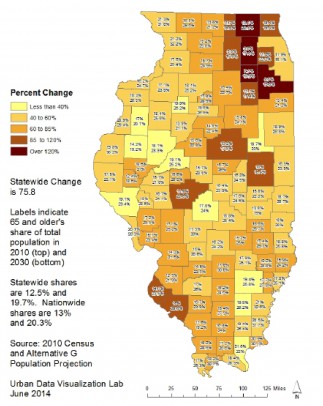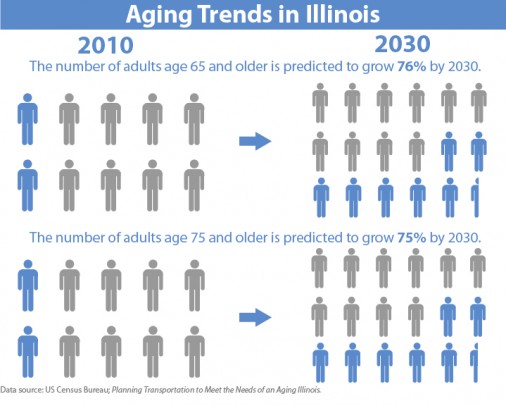‘Aging Illinois’ requires better intergovernmental cooperation
One of every eight Illinoisans are over age 60. That number will rise to one in five by 2030.
Municipalities throughout Illinois will need to improve transportation options, add a variety of housing types, and strengthen health and human services to meet the day-to-day needs of the aging population, according to a new report by researchers at the University of Illinois at Chicago.
“The growth in the number of older adults in Illinois and the United States up to 2030 should not be viewed as a one-time ‘pig in a python’ phenomenon. For the U.S. as a whole, as presented in the Census Bureau projections to 2060, a combination of increased lifespans, large post-baby-boom generations, and immigration patterns will produce continuing increases in the older adult population,” the report states.
By 2030, Illinois is expected to experience a 76 percent gain (648,129 residents) in the population aged 65 to 74, an 80 percent gain (418,798 residents) in those aged 75 to 84, and a 65 percent gain (152,866 residents) in those over 85.

Change in population aged 65 and older in Illinois counties, 2010 to 2030. (Click for larger image.)
For 10 years, Illinois has addressed the transportation needs of older adults as part of its Human Services Transportation Plan in coordination with the state’s 13 Area Agencies on Aging. The UIC report, “Planning Transportation to Meet the Needs of an Aging Illinois: An Assessment,” presents a snapshot of the plan’s impact to date and discusses promising practices, enduring issues and recommendations.
The researchers made three main recommendations:
- Add housing types geared to aging adults. Municipalities should change zoning laws to allow developers to build multifamily housing on smaller lots to accommodate older adults planning to downsize.
- Enhance home and community accessibility. Older adults will be able to stay in their homes longer if homes can be converted for those with disabilities or limited mobility. New construction should offer greater accessibility.
- Focus on older adults in rural communities. Small towns across Illinois have a greater concentration of older adults than the state as a whole. Older residents in rural areas may be more isolated than those in cities and may face greater challenges in getting medical care and other services.
The researchers further recommend that agencies:
- Coordinate transportation planning at the state, regional and local levels to eliminating barriers to federal funding and bipartisan congressional support.
- Create more efficient shared services and multimodal regional options.
- Develop “one click/one call” services statewide among coordinated transportation services.
- Consider replicating or expanding federal programs like the Community Development Block Grant or Transportation Investments Generating Economic Recovery (TIGER) grants.
The report was prepared by the Nathalie P. Voorhees Center for Neighborhood and Community Improvement with the Urban Transportation Center, both research units of the UIC College of Urban Planning and Public Affairs.

